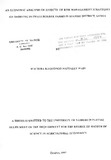| dc.description.abstract | This study investigated the risks facing the smallholder dairy farmers and examined how income sources and risk management strategies used by the farmers affect the dairy enterprise. The study was carried out in Limuru Division, Kiambu District using both primary and secondary data obtained from 35 farmers and the Division's offices of Ministry of Agriculture, Livestock and Development and Marketing The data collected were analyzed using both descriptive analysis and simulations using TIES (Technology Impact Evaluation System) The results of the study indicated that:
(i) risk management strategics used by farmers interfere with intensification of dairying These strategies included:
- matching, where a farm produced much of the food it consumes reducing household exposure to market risk.
- input parsimony, where a household reduced fluctuations in net income by restricting the use of inputs,
- diversification, where a household expected income is stabilized by diversifying income sources and ensuring the incomes do not all vary in the same direction and at the same time.
(ii) sources of incomes, such as off-farm incomes, that increase and stabilize household income tend to facilitate intensification of dairying, households with higher and more stable incomes intensity dairying, with high concentrate feeding and health services;
(iii) intensification of dairying which involves increased concentrate feeding and health services leads to higher but less stable and more risky incomes which are less preferred by farmers, and (v) cash flow problems and risk posed by available credit is a major constraint in most farm economies and adoption of dairy technologies
The following recommendations arise from the results of this study
(i) The implicit risk associated with dairy intensification (increased concentrate feeding and animal health services) should be reduced to enhance the adoption of the dairy technology This may be achieved through development of a competitive dairy sector which ensures a potentially high and relatively more stable milk prices by encouraging more processors, distributors and retailers in the sector.
(ii) Infrastructure such as roads should be improved to enable easy transportation of milk throughout the year This would also enhance farmers' accessibility to agricultural inputs (such as concentrates and fertilizer) throughout the year reducing their seasonal price fluctuations caused by poor or lack of roads.
(iii) Farms should be encouraged to undertake additional activities which stabilize household incomes to enable them adopt dairy technologies without exposing their households to additional risk Activities which help stabilize household incomes such as off-farm activities facilitate adoption of dairy technologies by the risk averse farmers,
(iv) Credit availability and lending terms should be improved in order to boost daily productivity Credit is instrumental in adoption of technologies that involve additional cost if the adoption is to take place without adversely affecting the smallholder’s income security.
(v) Cooperatives should be encouraged to broaden their services and undertake most of the services previously provided by the government. For example, beside providing A.I and animal health services a dairy cooperative should be able to provide technical advices on crop husbandry and credit according to the needs of the members | en_US |

